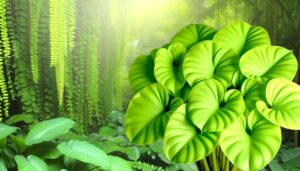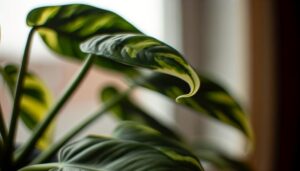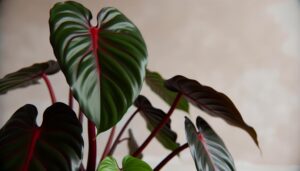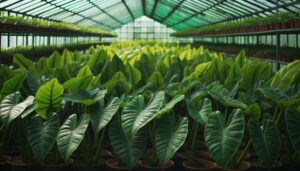What Is Philodendron Verrucosum 'Incensi'?
Philodendron verrucosum 'Incensi' is a distinctive species within the Araceae family, native to Central and South America's tropical rainforests. It thrives in environments of high humidity and diffused light.
The plant is noted for its velvety leaf texture and intricate vein patterns, which augment its ornamental value. Characterized by a climbing and trailing growth habit, it utilizes aerial roots for stability and nutrient absorption.
Best growth requires bright, indirect light, well-aerated substrates, and stringent humidity control measures. Effective propagation involves stem cuttings, emphasizing genetic consistency and high humidity.
Further insights into cultivation practices and pest management await.
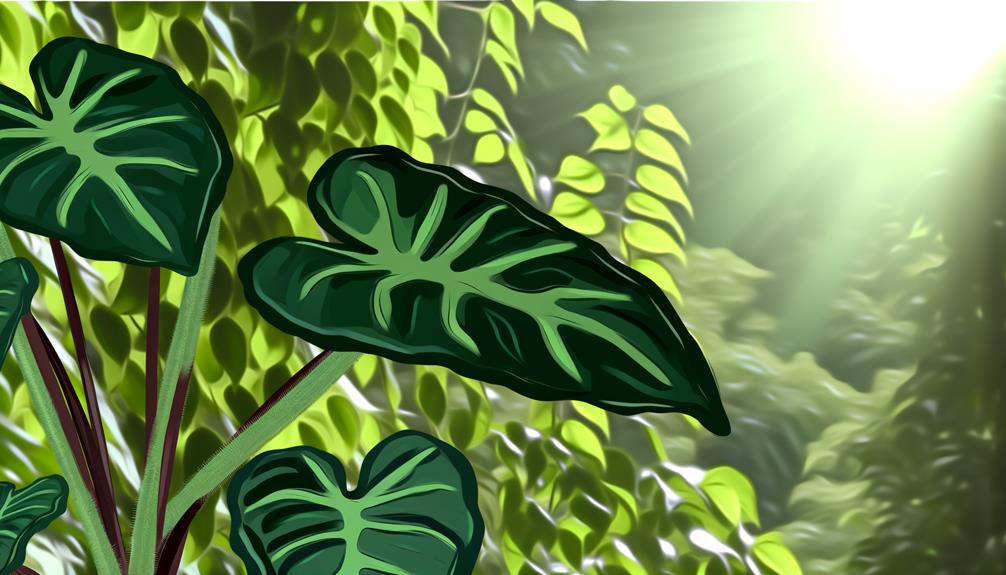
Key Takeaways
- Philodendron Verrucosum 'Incensi' is a tropical plant belonging to the Araceae family, native to Central and South America.
- It features velvety leaves with striking vein patterns, making it popular in ornamental horticulture.
- The plant thrives in high humidity and diffuse light, avoiding direct sunlight to prevent leaf scorch.
- It has a climbing and trailing nature with aerial roots, adaptable to various growth environments.
- Proper care includes well-draining substrate, adequate humidity, and regular pest and disease inspections for healthy growth.
Origins of Philodendron Verrucosum
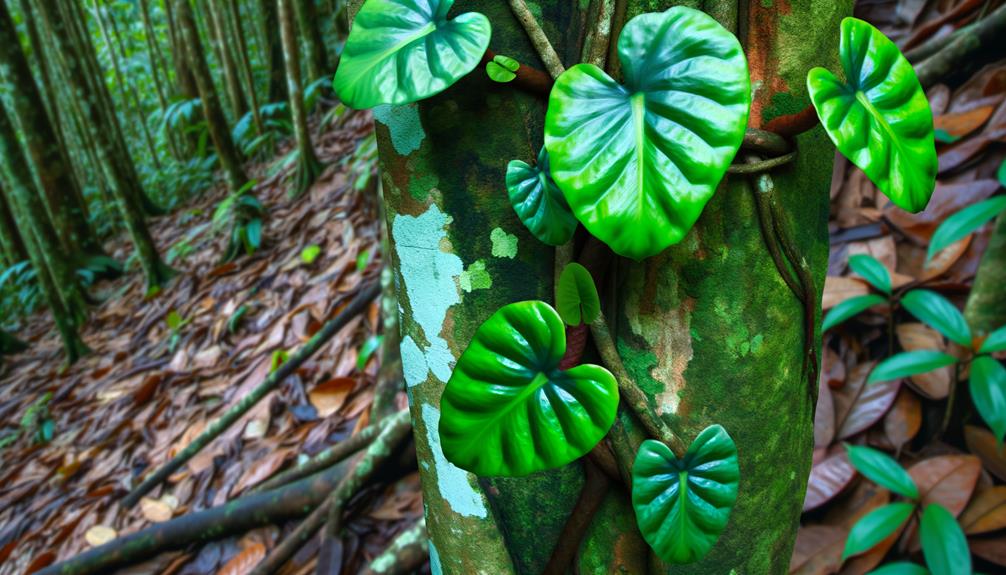
Philodendron verrucosum, a species within the Araceae family, originates from the tropical rainforests of Central and South America, specifically ranging from Costa Rica to Ecuador. This species thrives in the understory layer of these biodiverse ecosystems, where it benefits from the high humidity and diffuse light filtered through the forest canopy.
Belonging to the genus Philodendron, P. verrucosum is part of the order Alismatales, class Liliopsida, and division Magnoliophyta. The plant's natural habitat provides rich, well-drained soils, allowing for vigorous growth and adaptation to low-light conditions.
These ecological parameters contribute significantly to its morphological and physiological traits, enabling P. verrucosum to maintain its distinctive phenotypic characteristics in both natural and cultivated environments.
Unique Characteristics
Philodendron verrucosum 'Incensi' is classified within the Araceae family. It is distinguished by its unique velvety leaf texture, which imparts a tactile softness and visually appealing sheen.
The foliar morphology is further enhanced by striking vein patterns. These patterns are characterized by pronounced, contrasting venation that provides a dramatic visual contrast against the deep green lamina.
These distinctive traits contribute to its aesthetic and botanical appeal, making it a prominent specimen in ornamental horticulture.
Velvety Leaf Texture
One of the most striking features of Philodendron verrucosum 'Incensi' is its velvety leaf texture, which can be attributed to the presence of numerous trichomes covering the leaf's surface. These trichomes, or hair-like structures, create a soft, tactile experience and contribute to the plant's distinctive appearance.
Belonging to the family Araceae, Philodendron verrucosum 'Incensi' demonstrates a unique adaptation in which these trichomes likely serve protective functions against herbivory and excessive water loss. The adaxial (upper) side of the leaves exhibits a rich, velvety surface, while the abaxial (underside) may also display a similar texture albeit less pronounced.
This characteristic makes the plant highly desirable for collectors and botany enthusiasts who appreciate its unique tactile and visual qualities.
Striking Vein Patterns
The intricate venation of Philodendron verrucosum 'Incensi' manifests as a striking network of prominent, often reddish veins that contrast vividly against the deep green lamina, enhancing both its aesthetic appeal and taxonomic distinctiveness within the Araceae family.
These venation patterns are not merely ornamental but serve essential physiological functions, such as facilitating efficient nutrient and water transport. The pronounced reticulate venation is characteristic of this species, providing structural support to the delicate, velvety leaves.
Additionally, the combination of vivid veins and lush green foliage creates a visually enthralling specimen, distinguishing it from other members of the Philodendron genus. This unique venation pattern underscores the plant's evolutionary adaptations to its native tropical habitats, contributing to its desirability among botanists and horticulturists.
Leaf Texture and Color
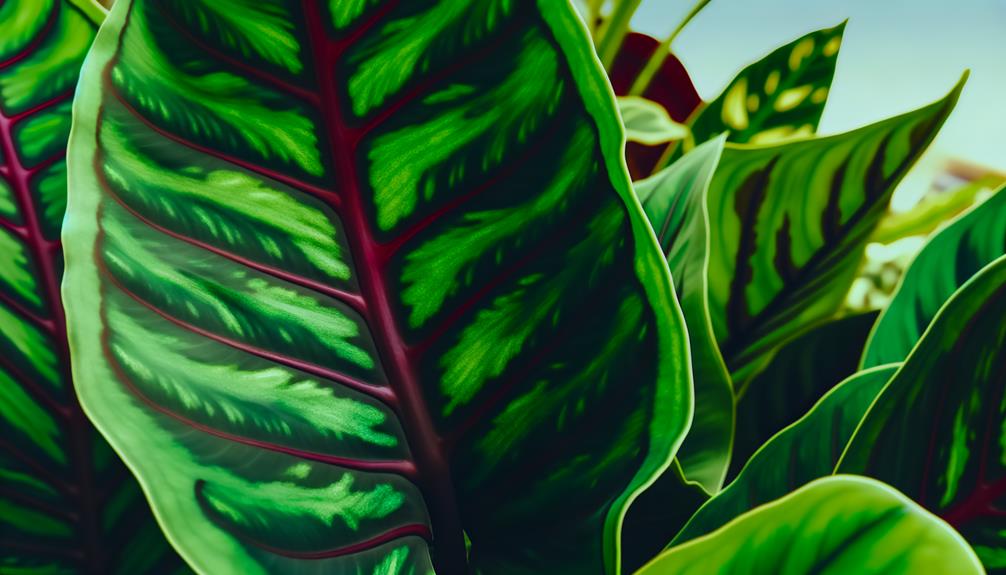
Characterized by a velvety texture, the leaves of Philodendron verrucosum 'Incensi' exhibit a striking combination of deep green hues interspersed with prominent lighter veins. This unique texture is attributed to the specialized epidermal cells, which create a tactilely soft surface. The coloration results from chlorophyll distribution and vascular tissue arrangement, enhancing the plant's aesthetic appeal.
| Leaf Characteristics | Description | Visual Impact |
|---|---|---|
| Texture | Velvety | Tactile and visually luxurious |
| Primary Color | Deep Green | Rich, lush appearance |
| Vein Color | Prominent Lighter Veins | Intricate, contrasting patterns |
The harmonious interplay of velvety texture and vivid coloration positions Philodendron verrucosum 'Incensi' as a sought-after species within the Araceae family for both botanical enthusiasts and interior decorators.
Growth Habit
Philodendron verrucosum 'Incensi' exhibits a distinct growth habit characterized by its climbing and trailing nature, facilitated by its aerial roots that anchor to nearby structures.
The species demonstrates significant leaf size variation, with juvenile leaves being markedly smaller and differing morphologically from the mature, larger leaves.
This growth pattern allows for adaptive colonization in both terrestrial and epiphytic environments, enhancing its ecological versatility.
Climbing and Trailing Nature
Exhibiting a strong hemiepiphytic growth habit, Philodendron verrucosum 'Incensi' adeptly climbs and trails, utilizing aerial roots to anchor itself to surrounding structures. This species, belonging to the Araceae family, demonstrates impressive adaptability in both natural and cultivated environments.
The aerial roots, emerging from nodes along the stem, facilitate attachment to tree trunks or support structures, enabling vertical and horizontal growth. This climbing mechanism allows P. verrucosum 'Incensi' to maximize light exposure and make use of available space efficiently.
The plant's ability to trail across surfaces also enhances its ornamental value, making it a popular choice for indoor horticulture. Understanding its climbing and trailing nature is essential for best care and cultivation, ensuring strong growth and aesthetic appeal.
Leaf Size Variation
Leaf size variation in Philodendron verrucosum 'Incensi' is influenced by multiple factors, including light availability, humidity levels, and overall plant age. This species, belonging to the Araceae family, exhibits significant plasticity in foliar dimensions.
Ideal light conditions promote larger, more robust leaves, while insufficient light results in smaller, less vigorous growth. Humidity levels also play a crucial role; high ambient humidity facilitates expansive leaf development, characterized by pronounced venation and vibrant coloration.
Juvenile plants typically exhibit smaller leaves, which gradually increase in size as the plant matures. Additionally, environmental stressors such as inconsistent watering or subpar temperatures can further impact leaf morphology.
Understanding these variables is essential for cultivating Philodendron verrucosum 'Incensi' to its full ornamental potential.
Ideal Lighting Conditions

Ideal lighting conditions for Philodendron verrucosum 'Incensi' require bright, indirect light to replicate the dappled sunlight of its native tropical rainforest habitat. Classified under the Araceae family, this species thrives in environments where light is filtered through the canopy, creating diffused illumination.
Direct sunlight can cause photodamage to its delicate, velvet-textured leaves, leading to chlorosis and necrosis. Best light levels facilitate photosynthesis without risking the structural integrity of the foliage. Positioning the plant near north or east-facing windows, or using sheer curtains to diffuse sunlight, can emulate ideal conditions.
Artificial grow lights with an intensity of 10,000 to 20,000 lux can also suffice, ensuring the photoperiod aligns with the plant's circadian rhythms for robust growth.
Watering Requirements
Proper watering practices for Philodendron verrucosum 'Incensi' are essential, as this species requires a consistently moist substrate without becoming waterlogged to mimic its natural epiphytic environment. This Araceae family member thrives in conditions where the root system receives adequate hydration without being submerged.
Overwatering can lead to root rot and other phytopathological issues. To achieve ideal moisture levels, it is advised to water when the top inch of the substrate feels slightly dry to touch. Utilizing distilled or rainwater can prevent the accumulation of harmful minerals.
Additionally, ensuring proper drainage through the use of well-ventilated pots can aid in maintaining the delicate balance between hydration and aeration, thereby fostering healthy growth and vigor in Philodendron verrucosum 'Incensi'.
Soil Preferences
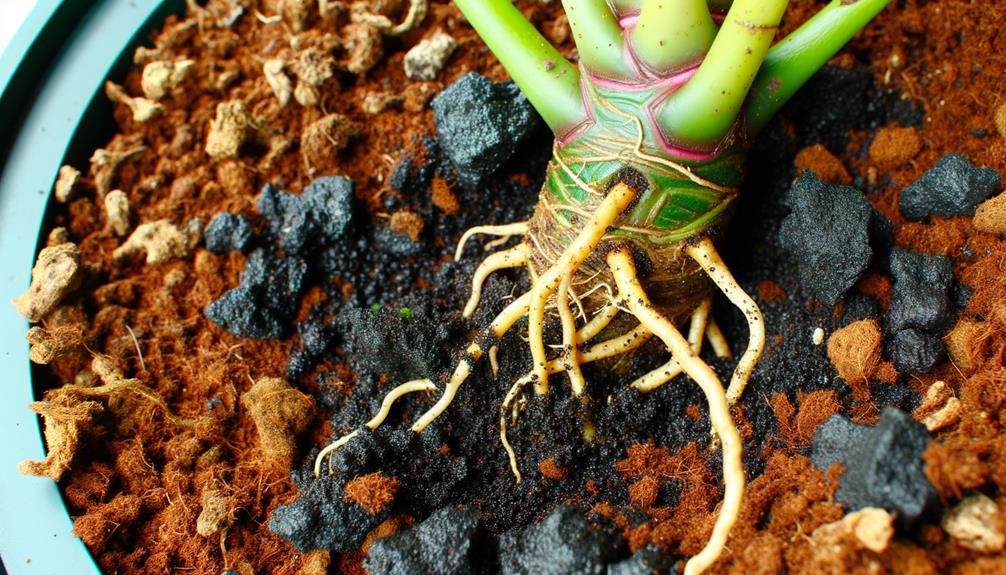
For prime growth, Philodendron verrucosum 'Incensi' requires a well-draining, aerated substrate rich in organic matter to replicate its natural epiphytic habitat. This species, classified under the Araceae family, thrives in a soil medium that ensures both moisture retention and sufficient air circulation to its roots. Best soil composition plays a pivotal role in preventing common issues such as root rot and promoting vigorous growth.
Key soil components include:
- Orchid bark: Enhances aeration and mimics natural habitat conditions.
- Perlite: Improves drainage, preventing waterlogging.
- Coconut coir: Retains moisture while providing a lightweight structure.
- Sphagnum moss: Regulates humidity around the root zone.
- Activated charcoal: Keeps the substrate fresh and free from toxins.
Humidity Needs
Maintaining high moisture levels, typically between 70% and 90%, is essential for the best growth of Philodendron verrucosum 'Incensi', as it mimics the plant's native tropical rainforest environment. Belonging to the Araceae family, this species thrives in moisture-rich atmospheres which facilitate peak physiological processes, such as transpiration and nutrient uptake. Low humidity can lead to desiccation of foliage, manifesting as browning leaf edges and stunted growth.
To achieve these conditions, employing a humidifier or placing the plant in a terrarium is recommended. The utilization of pebble trays filled with water or frequent misting can also aid in maintaining adequate moisture. Consistent monitoring with a hygrometer ensures that the ambient moisture remains within the ideal range, promoting robust and verdant growth.
Propagation Methods
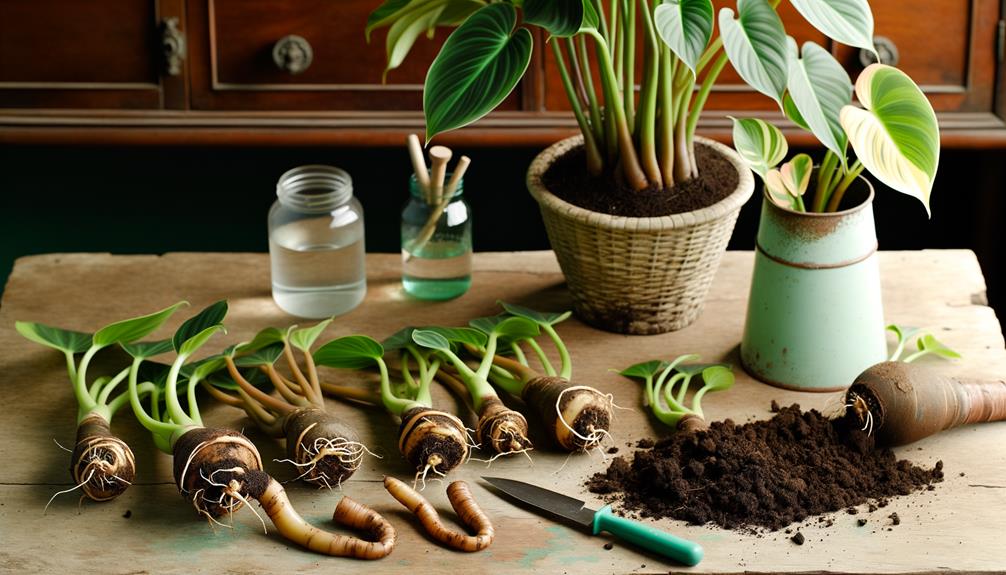
Maintaining ideal humidity levels also plays a significant role in the success of propagation methods for Philodendron verrucosum 'Incensi'. Propagation typically involves stem cuttings, a method that guarantees genetic consistency and vigor. This Araceae family member thrives when cuttings are taken from robust, disease-free parent plants.
Key steps include:
- Cutting Selection: Choose healthy stems with at least one node and a few leaves.
- Sterilization: Use sanitized tools to prevent pathogen transfer.
- Rooting Medium: Utilize a well-draining mix, such as sphagnum moss or perlite.
- Humidity Management: Maintain high humidity, around 70-90%, to encourage root development.
- Light Exposure: Provide indirect light to avoid leaf scorch while promoting photosynthesis.
Common Pests and Diseases
Philodendron verrucosum 'Incensi', a member of the Araceae family, is susceptible to a range of pests, including aphids (Aphidoidea), spider mites (Tetranychidae), and mealybugs (Pseudococcidae).
Disease identification is critical for effective management and includes recognizing symptoms such as chlorosis, necrotic spots, and wilting, often caused by pathogens like Pythium and Phytophthora spp.
Preventive care practices, including proper sanitation, humidity control, and regular inspection, are essential to sustain the plant's health and vigor.
Common Plant Pests
In the cultivation of Philodendron verrucosum 'Incensi', vigilance is required to manage common pests. These include spider mites (Tetranychus urticae), aphids (Aphididae), and mealybugs (Pseudococcidae), which can compromise plant health and growth. These pests feed on plant sap, leading to chlorosis, stunted growth, and potential secondary infections. Effective pest management begins with regular inspections and early intervention.
Spider mites (Tetranychus urticae) are minuscule arachnids causing stippling and webbing.
Aphids (Aphididae) are soft-bodied insects that excrete honeydew, fostering sooty mold.
Mealybugs (Pseudococcidae) are cottony pests that induce leaf yellowing and wilting.
Scale insects (Coccoidea) are camouflaged pests that create waxy coverings on stems.
Thrips (Thysanoptera) are slender insects that cause silvery streaks on foliage.
Understanding these pests' biology and behavior is essential for effective control.
Disease Identification Tips
Effective pest management is complemented by the precise identification of diseases that can afflict Philodendron verrucosum 'Incensi', including bacterial leaf spot (Xanthomonas campestris), fungal root rot (Pythium spp.), and viral infections (Potyviridae family). Bacterial leaf spots typically present as water-soaked lesions that may coalesce, leading to necrosis. Fungal root rot manifests through wilting, yellowing leaves, and a decayed root system. Viral infections, identifiable via mosaic patterns and distorted growth, impede physiological functions.
| Disease | Pathogen | Symptoms |
|---|---|---|
| Bacterial Leaf Spot | Xanthomonas campestris | Water-soaked lesions, necrosis |
| Fungal Root Rot | Pythium spp. | Wilting, yellowing leaves, root decay |
| Viral Infections | Potyviridae family | Mosaic patterns, distorted growth |
Accurate diagnosis guarantees targeted treatment, safeguarding the plant's health.
Preventive Care Practices
Implementing preventive care practices is crucial to maintaining the health and vigor of Philodendron verrucosum 'Incensi', especially in mitigating the risks posed by common pests and diseases. This species, classified under the Araceae family, is susceptible to infestations and infections that can compromise its morphological and physiological integrity. Routine inspection and early intervention are essential.
- Aphids: Regularly check undersides of leaves for these sap-sucking insects.
- Spider Mites: Maintain high humidity to deter these arachnids, which thrive in dry conditions.
- Mealybugs: Inspect leaf axils for these cotton-like pests and treat with horticultural oil.
- Fungal Infections: Guarantee adequate air circulation to prevent pathogen proliferation.
- Bacterial Leaf Spot: Avoid overhead watering to reduce the risk of bacterial spread.
Benefits of Owning One
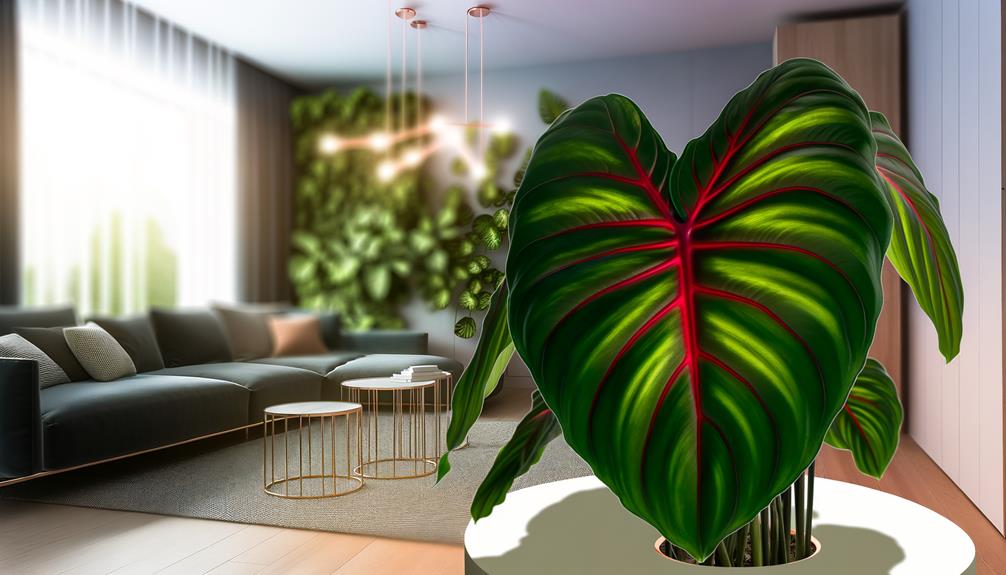
Owning a Philodendron verrucosum 'Incensi' offers numerous advantages, including improved air quality and enhanced aesthetic appeal due to its distinctive, velvety foliage and robust growth habit. As a member of the Araceae family, this epiphytic species aids in the removal of airborne pollutants, thereby contributing to a healthier indoor environment. Additionally, its lush, heart-shaped leaves with striking venation make it an excellent ornamental plant, suitable for various interior decor styles.
| Benefit | Description |
|---|---|
| Air Purification | Removes toxins such as formaldehyde and benzene from the air. |
| Aesthetic Appeal | Features velvety, heart-shaped leaves with prominent venation. |
| Low Maintenance | Requires minimal care, making it ideal for busy individuals. |
| Humidity Regulator | Increases ambient humidity through transpiration. |
| Biophilic Design | Enhances psychological well-being by adding natural elements to indoor spaces. |
Conclusion
Philodendron verrucosum 'Incensi' exemplifies the intricate beauty and adaptability of tropical flora. With its unique leaf texture, vibrant coloration, and specific environmental needs, it represents a fascinating subject for botanical study and cultivation.
How can understanding the precise care requirements of such species enhance horticultural practices and biodiversity conservation efforts?
Ultimately, the philodendron verrucosum 'Incensi' not only enriches indoor plant collections but also contributes to broader ecological knowledge and appreciation.

